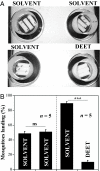Mosquitoes smell and avoid the insect repellent DEET
- PMID: 18711137
- PMCID: PMC2518096
- DOI: 10.1073/pnas.0805312105
Mosquitoes smell and avoid the insect repellent DEET
Abstract
The insect repellent DEET is effective against a variety of medically important pests, but its mode of action still draws considerable debate. The widely accepted hypothesis that DEET interferes with the detection of lactic acid has been challenged by demonstrated DEET-induced repellency in the absence of lactic acid. The most recent hypothesis suggests that DEET masks or jams the olfactory system by attenuating electrophysiological responses to 1-octen-3-ol. Our research shows that mosquitoes smell DEET directly and avoid it. We performed single-unit recordings from all functional ORNs on the antenna and maxillary palps of Culex quinquefasciatus and found an ORN in a short trichoid sensillum responding to DEET in a dose-dependent manner. The same ORN responded with higher sensitivity to terpenoid compounds. SPME and GC analysis showed that odorants were trapped in conventional stimulus cartridges upon addition of a DEET-impregnated filter paper strip thus leading to the observed reduced electrophysiological responses, as reported elsewhere. With a new stimulus delivery method releasing equal amounts of 1-octen-3-ol alone or in combination with DEET we found no difference in neuronal responses. When applied to human skin, DEET altered the chemical profile of emanations by a "fixative" effect that may also contribute to repellency. However, the main mode of action is the direct detection of DEET as indicated by the evidence that mosquitoes are endowed with DEET-detecting ORNs and corroborated by behavioral bioassays. In a sugar-feeding assay, both female and male mosquitoes avoided DEET. In addition, mosquitoes responding only to physical stimuli avoided DEET.
Conflict of interest statement
The authors declare no conflict of interest.
Figures








Comment in
-
DEET repels ORNery mosquitoes.Proc Natl Acad Sci U S A. 2008 Sep 9;105(36):13195-6. doi: 10.1073/pnas.0807167105. Epub 2008 Sep 4. Proc Natl Acad Sci U S A. 2008. PMID: 18772369 Free PMC article. No abstract available.
References
-
- Moore SJ, Debboun M. In: Insect repellents: Principles, methods, and uses. Debboun M, Frances SP, Strickman D, editors. Boca Raton, FL: CRC; 2007. pp. 3–30.
-
- Davis EE, Sokolove PG. Lactic acid-sensitive receptors on the antennae of the mosquito, Aedes aegypti. J Comp Physiol. 1976;105:43–54.
-
- Davis EE. Insect repellents: Concepts of their mode of action relative to potential sensory mechanisms in mosquitoes (Diptera: Culicidae) J Med Entomol. 1985;22:237–243. - PubMed
-
- Boeckh J, et al. Acylated 1,3-aminopropanols as repellents against bloodsucking arthropods. Pestic Sci. 1996;48:359–373.
-
- Dogan EB, Ayres JW, Rossignol PA. Behavioural mode of action of deet: Inhibition of lactic acid attraction. Med Vet Entomol. 1999;13:97–100. - PubMed
Publication types
MeSH terms
Substances
Grants and funding
LinkOut - more resources
Full Text Sources
Other Literature Sources
Medical
Miscellaneous

